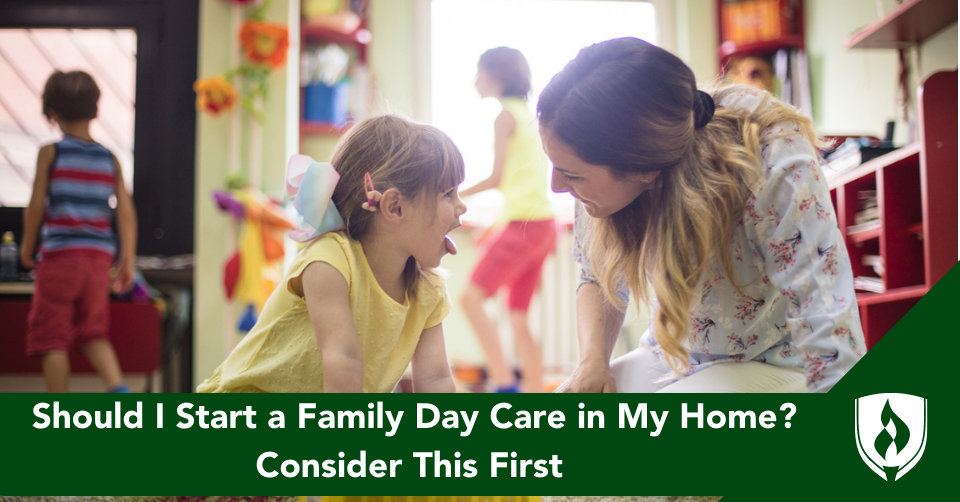
Many people never realize just how common family daycares (or home-based child care businesses) are. These small businesses fill crucial needs in their areas. There are over 280,000 regulated home daycares in the U.S., which is nearly three times more than the number of licensed child care centers.1
Operating a family daycare is a delightful blend of laughter, tears, sticky fingers and infinite moments that will leave you questioning your sanity. The whole family daycare operation is much more than just babysitting – it's about creating a safe and nurturing environment where little ones can grow, learn and explore. It's about building a home away from home through early education and child development.
Maybe you're a teacher leaving the school system, or perhaps you've just been ruminating on this idea for a while. Maybe you have young ones at home and want to work while caring for them. Whatever your circumstances, if you’ve thought about starting a family child care program in your house here are some things to consider as you embark on this wild and wonderful adventure.
So, grab your apron and wet wipes and prepare for a rollercoaster ride of miniature proportions.
What is family daycare?
Family daycare, also known as home daycare or in-home childcare, refers to a type of childcare service provided in a home setting by an individual caregiver or a small team of caregivers.
In family day care, children are cared for and supervised in a home-like environment, typically within the caregiver's own residence. Family child care providers offer a range of services, including child care, playtime, educational activities, meals and sometimes even overnight care.
Most of the time, family child care consists of a small group of children – usually a provider cares for no more than 6 children.2 In some areas, this could be a much smaller number than traditional daycare centers, offering a more personalized and intimate experience for the children in their provider's home.
As a care provider, you can decide which age groups you want to care for. Just be sure to check local regulations on infant care, toddler and school aged children.
Typically, an in-home provider adheres to licensing and safety regulations and may follow a structured curriculum or provide a more flexible approach based on the needs and preferences of the children and their families. Family daycare can be a popular choice for parents seeking a home-like atmosphere, individualized attention and the convenience of a caregiver's own residence.
Starting a home family day care
Starting a family daycare can be overwhelming. Even if you do have experience with young kids, there is a lot to consider, so we'll take it nice and easy.
7 important home child care factors you need to consider
Becoming an in-home family child care provider involves several steps. While the specific process can vary depending on your location and local regulations, here is a general outline of the steps involved in starting a family day care:
1. Consider EVERYTHING
Tall order, I know. But this is where you start. Let's make sure you're built for this. First things first, consider your temperament and environment, including:
- Will you be able to tolerate the noise, mess (sometimes destruction) and chaos?
- Do you have enough energy to work long hours with little – and I mean little – time to rest?
- Do you have the space and additional toys?
- What safety measures or childproofing will you need to put in place?
- Do all the people sharing your home agree with this idea?
- If you have kids, how will they feel about this adjustment?
- If you have pets, how would they behave? Where might you keep them?
- Will you mind being in your home all day?
- Are you ready to take action in case of an emergency? Do you know CPR or first aid?
- Do you plan to hire help or work alone?
When it comes to the business side of things, there’s an even longer list of questions, concerns and considerations. You'll need to develop policies and procedures, along with a daily plan of activities. You may want to plan on advertising and marketing to attract the type of clients you want.
If you were hoping to sit on your couch and passively observe the children happily playing together, you should adjust your expectations now. Opening and running a home daycare business is hard work.
If you get excited about pouring your personality into a loving child care environment, you are on the right track! Literally paint the walls with your vision and invest the genuine effort necessary to create a business that truly cares, in every sense of the word.
2. Consider your finances – Develop your business plan
Before opening your front door to customers, have your business plan in place. It’s not always the most interesting part of this process, but it's definitely for the best. Understanding your business and its expenses is the catalyst to everything else, including what you decide to charge for your family child care services.
You will need to track your earnings and budget for expenses such as insurance, inspections, certification, advertising, cleaning supplies, safety equipment, any possible staffing, additional toys, food and drink and any other items necessary for a fully-functional family child care program.
Additionally, it is beneficial to explore your state's Child Care and Development Fund Administrators, who are dedicated to supporting emerging family day care programs, early childhood education providers and the well-being of young children.3 These official state organizations can offer valuable guidance, connect you with resources and provide information on potential funding opportunities.
According to the U.S. Office of Child Care, an impressive 80% of licensed child care programs in the country have received some kind of support from their initiatives.4 This includes both center-based and home-based daycares.
3. Legal considerations, regulations and licensing requirements
The next step you must take is to understand your state's licensing requirements and regulations. Call your state agency and ask any specific questions you may have.
This will help you to determine the licensing or registration process for operating an in-home family daycare in your jurisdiction. You may need to complete applications, other paperwork and background checks. You’ll also need to ensure that your home and premises meet health, safety and zoning requirements.
In some areas, you may have the choice to operate a family child care either with or without a license.5 However, it is strongly recommended to consider obtaining a license for your home daycare and familiarize yourself with the associated requirements.
Put yourself in the shoes of a parent for a moment: Your child is your most precious little treasure. Would you truly feel at ease leaving them at a stranger's residence? Or would you prefer to enroll them in a licensed, home-inspected and regulated childcare center where you know regulators have taken a close look at the care provider and their home? Exactly.
Getting a license for your family-based day care ensures that parents can trust your program to adhere to the established standards set by the government. Also, that license opens various funding and professional development opportunities that can contribute to the success of your business.
4. Consider certification
You may need to obtain specific certifications based on your area. Here are some of the most common and necessary certifications most jurisdictions require family child care providers to have:6
Childcare license or registration
Most jurisdictions require in-home daycare providers to obtain a childcare license or registration. This process typically involves meeting specific criteria related to health, safety and operational standards, as well as passing inspections.
First aid and CPR certification
It is essential for daycare providers to have current First Aid and CPR certifications. These certifications ensure that you have the knowledge and skills to handle medical emergencies and provide immediate assistance to the children if needed. If you open your center to infant care, you may need infant-specific CPR certification.
Safe sleep training
Some areas may require providers to complete safe sleep training to ensure that infants and young children are provided with a safe sleep environment, reducing the risk of Sudden Infant Death Syndrome (SIDS). This is very worth doing and an extra way to show potential clients that your business is a good one.
Food handling and nutrition training
You may need to obtain a food handler's permit or undergo food safety training if you plan to serve food or snacks. This ensures that you are knowledgeable about safe food handling practices and proper nutrition for young children.
Background checks
In many jurisdictions, a family child care provider (and anyone residing in the home) may be required to undergo background checks, including criminal record checks and sometimes fingerprinting to ensure the safety and well-being of the children.
5. Establish policies and procedures
Next, you'll want to look into developing clear and comprehensive policies and procedures for your day care, including enrollment processes, ages, daily routines, health and safety protocols, discipline policies, communication with parents and any other relevant guidelines.
6. Consider your curriculum
The responsibility lies with you to create an enriching and secure experience. You'll want to provide care that integrates play, education and socialization through age-appropriate activities and learning experiences. Striking a balance between structured and unstructured time is essential in fostering a well-rounded experience for the children in your care.
You should aim to support the child's development in every way including social, emotional and cognitive growth. Plan to read up on early childhood development or even pursue an early childhood education degree program.
A credential you might see in this field is the CDA. CDA stands for Child Development Associate. It is a nationally-recognized credential in early childhood education. The CDA credential is awarded to individuals who have demonstrated competency in child development, effective teaching practices and creating a safe and nurturing environment for children.
CDAs are commonly pursued by professionals working in daycare centers, preschools, home-based daycare and other early childhood settings to strengthen their knowledge and skills in caring for young children.
7. Consider your space
Now this part can be pretty fun. It's time to designate an appropriate space in your own home for the daycare. Where will the children spend their time with you? How will you childproof the area and arrange age-appropriate furniture toys and equipment? If you have a theme you’d like to go for, how will you decorate?
The pros and cons of operating your own home daycare
While starting an in-home daycare can bring excitement and financial benefits, it also entails potential stress and challenges. Taking the time to consider both the positive and negative aspects, along with developing a solid action plan, increases the likelihood of transforming it into a successful and enduring career.
Wondering if you should dive into this industry means weighing the pros and cons. You may already have some of your own. Add these to your lists.
Some pros to running a family daycare
- You might get more quality time with your child(ren) throughout the day.
- It’s possible to generate income and avoid childcare expenses of your own.
- Like any entrepreneur, you have the freedom to be your own boss.
- You can decide what schedule your daycare will run on.
- You can save on commuting costs and stress by working from home.
- The work can be incredibly fulfilling on a daily basis.
- Building close relationships with children and families can brighten your world.
Some cons to running a family daycare
- Cleaning can feel like a constant task.
- You may be exhausted by the time kids go home, but you’ll still have administrative tasks to handle.
- Finding time for grown-up conversations or outings can be challenging.
- Your home, furniture and toys will likely experience wear and tear from the children.
- Increased exposure to germs may lead to more frequent illnesses for you and your family.
- Dealing with occasional late payments or pick-ups is a common stressor.
- Your home may feel more like a workplace, reducing relaxation opportunities.
How much money can be made?
The potential income from opening a family child care program in your home can vary depending on several factors, including location, the number of children enrolled, your rates and operating expenses. It's important to note that income will probably fluctuate based on demand and client turnover.
Generally, home daycare providers charge weekly or monthly fees per child, and the rates can range significantly depending on the region and the services provided. Conduct thorough market research, assess local competition and consider the operating costs involved to estimate the potential income from your home daycare accurately.
Childcare vs. daycare: What's the difference?
The terms "childcare" and "daycare" are often used interchangeably, but there are subtle distinctions to note. Childcare generally refers to the broader concept of providing care and supervision for children in a professional setting. It encompasses various types of care, including daycare, preschools, nurseries and even in-home care.
On the other hand, daycare specifically refers to a facility or program where parents can leave their children for a specific period, typically during working hours. Daycare centers usually offer structured activities, playtime, meals, and often follow a curriculum.
While both terms involve the care of children, daycare tends to focus on a specific time period, while childcare has a broader scope that can encompass various types of care and settings. It’s up to you to decide which term fits your plans best.
Are you ready to see a step-by-step guide?
If all this information doesn’t have you throwing in the towel, you might be the kind of person who can handle running a home daycare!
With dedication, preparation and a genuine love for children, opening a home daycare can be a wonderful opportunity for personal and professional growth. If you could see yourself really doing this, check out our article “ Your Step-by-Step Guide to Opening a Daycare” to get a detailed plan for how to proceed!
Rasmussen University ECE programs do not prepare students for licensed teaching positions in any public school setting, but students will have the opportunity to help shape the futures of young children from birth to age six in a childcare or non-public school setting or leadership role.
1Himama.com: Early Childhood Education Blog. Complete guide to starting and growing a home-based childcare center. Date accessed 6/6/23. https://www.himama.com/blog/complete-guide-to-starting-growing-a-home-daycare-center/
2Why Ratios Matter in Childcare Settings, Childcare Aware of Minnesota. Date accessed 6/14/2023. https://www.childcareawaremn.org/wp-content/uploads/2022/02/Why-Ratios-Matter-2022-final-1.31.22.pdf
3U.S. Department of Health and Human Services. State and Territory Child Care and Development Fund Administrators. Date accessed 6/5/23. https://www.acf.hhs.gov/occ/contact-information/state-and-territory-child-care-and-development-fund-administrators
4U.S. Department of Health and Human Services. ARP Child Care Stabilization Funding State and Territory Fact Sheets. Date accessed 6/5/23. https://www.acf.hhs.gov/occ/map/arp-act-stabilization-funding-state-territory-fact-sheets
5ChildCare.gov. What Is Child Care Licensing? Date accessed 6/6/23. https://childcare.gov/consumer-education/child-care-licensing-and-regulations
6ChildCare.gov. Staff Qualifications and Required Training. Date accessed 6/6/23.




